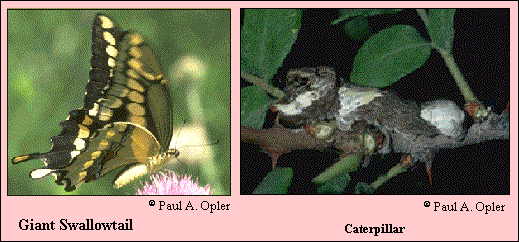Giant Swallowtail (Papilio cresphontes)

Identification: Forewing with diagonal band of yellow spots. Tails are edged with black and filled with yellow.
Life history: Males patrol for receptive females. Females lay single eggs on host leaves and twigs. Caterpillars resemble bird droppings and eat leaves and young shoots. Chrysalids hibernate.
Flight: Two in the north from May-September; all year in Florida and the Deep South.
Caterpillar hosts: Trees and herbs of the citrus family (Rutaceae) including Citrus species, prickly ash (Zanthoxylum americanum), and hop tree (Ptelea trifoliata).
Adult food: Nectar from lantana, azalea, bougainvilla, bouncing Bet, dame's rocket, goldenrod, Japanese honeysuckle, and swamp milkweed.
Habitat: Many locales including rocky and sandy hillsides near streams or gullies in the north; pine flats, towns, and citrus groves in the south.
Range: Throughout eastern North America west to the Rocky Mountains, south through the desert Southwest to South America. A rare stray to Quebec, North Dakota, and Bermuda.
Conservation: Not required in the United States.
Management needs: Caterpillars ("orange dogs") are occasional pests of citrus.
The Nature Conservancy Global Rank: G5 - Demonstrably secure globally, though it may be quite rare in parts of its range, especially at the periphery.